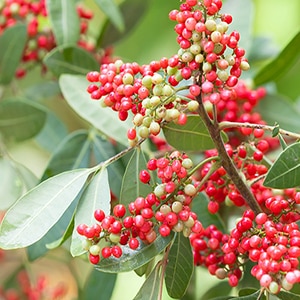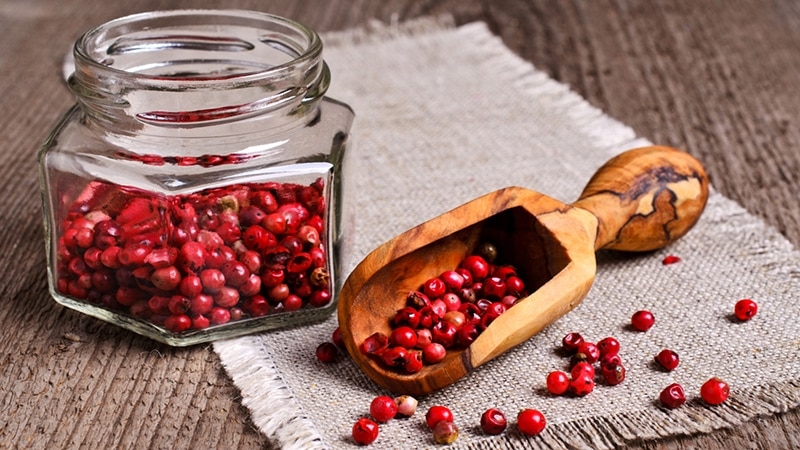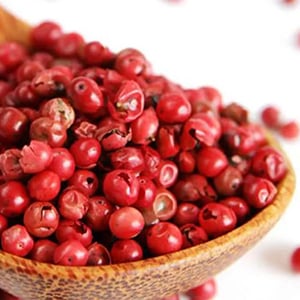How and where does pink pepper grow and in what areas is it used?
Pink, Peruvian, Brazilian pepper, chinoiserie – these are all names of one plant. It is not as popular as black or allspice, but it is endowed with unique qualities. It is widely used in cooking, cosmetology and perfumery. In this article we will talk about the beneficial properties of pink pepper, contraindications and features of its use.
What is pink pepper
Pink peas are the fruit of a flowering plant called the chinus plant, which is native to South America and does not have similar characteristics to the pepper tree. Its fruits are similar to pepper only in appearance and lack the usual pungency and bright spicy aroma. After flowering, clusters resembling small peas are formed. At first they are green in color, but as they ripen they turn red.
The peas have a tart taste, slightly sweetish and a not very pronounced peppery smell. This versatile seasoning is suitable for both savory and sweet dishes.

What does it look like
Shinus fruits are hollow inside, have a round shape, reminiscent of black peppercorns, with a diameter of 3-5 mm. When you press on the berry, you can feel a small black grain inside. In the photo you can see what pink pepper looks like on a tree.
How and where it grows
Shinus is an evergreen plant, a direct relative of pistachio and mango.. Grows in the form of shrubs or trees 10-15 m tall. Average life expectancy is 30 years. The branches look like a vine. Blooms yellow-white flowers in the form of tassels once a year.The flowers form peas: at first the fruits are green, then white and finally turn red. This is the form in which they are collected.
The plant loves the sun and grows not only in South America, but also in many countries with hot climates. However, only the Brazilian tree produces fruits that have spice qualities.
Composition and properties
Products with such a range of useful substances are rarely found in nature. The sinus contains:
- all B vitamins;
- vitamin C;
- vitamin E;
- vitamin PP;
- vitamin H;
- iron;
- potassium;
- calcium;
- manganese;
- sodium;
- phosphorus.
Surprisingly, pink pepper is quite high in calories: 100 g contains 250 kcal.
Nutrients:
- proteins – 5 g;
- carbohydrates – 40 g;
- fats – 8 g.
Anthocyanins in pepper act as antioxidants: they relieve inflammation and kill viruses.
Bioflavonoids are phenolic compounds that protect the body from the harmful effects of free radicals. Prevents skin aging and premature aging.
Gallic acid acts as an antibiotic and antiviral agent.
Smell and taste
Pink pepper does not smell of anything, but if you grind it, it gives off a faint aroma of citrus, mixed with the smell of cedar and pine. The taste is sweetish, fresh, resinous, with a slightly menthol aftertaste and a subtle peppery aftertaste. Considering the unstable aroma of shinus, it is recommended to use it immediately after grinding.
Uses of pink pepper
Shinus is used as:
- seasonings for meat dishes, vegetables, baked goods, preserves, desserts;
- cosmetic product;
- component of perfumes.
In cooking
Pink pepper is actively used in Mediterranean, Mexican, Brazilian and American cuisine.The spice improves the taste of meat and fish dishes and enhances the taste of poultry.
The light structure of the shinus easily transmits the aroma and does not require heat treatment. Experienced chefs add freshly ground pepper to hot dishes immediately before serving. This fully reveals the flavor of the spice.
Pink peppercorns go perfectly with any type of sea fish with a neutral taste. It adds a light smoky aroma and a little spiciness, revealing the taste of fish cooked over a fire.
Shinus is added to tonic drinks, cold dishes, cream soups, and sauces. They decorate desserts and sweet pastries.
Advice. Heat the peas in a hot frying pan. This way the aroma will open up and become brighter.
In cosmetology and perfumery
Pink pepper contains essential oil, which is used to prepare cosmetics:
- alcohol toners to eliminate acne and other skin rashes;
- scrubs from ground sinus based on heavy cream, honey, vegetable oils to get rid of stretch marks, cellulite, skin unevenness;
- masks made from ground pepper with cold-pressed olive oil and honey to enhance hair growth and eliminate dandruff.
The fresh, sparkling-spicy aroma of pink berries is used in top notes in the production of perfumes. Pepper helps enhance the composition and harmonizes with cardamom, nutmeg and incense. Pink pepper is used by Gucci, Giorgio Armani, Chanel, Yves Saint Laurent.
Benefits and harms
Shinus fruits contain a large amount of phenolic compounds that have a beneficial effect on the human body:
- kill viruses, fungi, bacteria;
- speed up metabolism;
- relieve spasms;
- prevent the risk of tumor development;
- relieve pain;
- improve blood circulation;
- break down fat deposits;
- alleviate the condition of arthritis and osteochondrosis;
- increase skin elasticity;
- tone;
- reduce fever during ARVI;
- stimulate digestion;
- improve appetite.
It is advisable to exclude pink pepper from the diet in case of a nut allergy. This is perhaps the only drawback of the spice.
Contraindications
People prone to allergic reactions are advised to consult a doctor before introducing pink pepper into their diet. If consumed in excess, it causes diarrhea.
Nutritionists advise treating sinus with caution if you suffer from:
- allergies;
- cardiovascular diseases;
- high blood pressure;
- pathologies of the gastrointestinal tract (gastritis, ulcers).
Harvesting and storing pink pepper
Pink peppers are harvested after ripening. This is indicated by the red color of the peas. Dry entirely in the open air. The spice is not sold in crushed form, as it instantly loses its woody-fruity aroma. Canned pink peppers in marinade are sometimes found on store shelves.
Dried berries are stored in glass jars or paper bags in a dark place for 1-2 years. Grind before use.
Read also:
How to cook peppers marinated in oil over the winter.
How to choose the right one when buying

Pink peas are not a scarce food. They are found in shops specializing in the sale of spices, markets and large supermarkets.
To buy a quality product:
- Pay attention to the date of collection and packaging.
- Choose pink or red peppercorns.Dark peas indicate unsuitability.
- Taste the spice. A high-quality product has a sharp and sweet taste, a light aroma of smoke and pine needles.
- Do not take pepper mixed with black and allspice. The sinus is lost against the backdrop of pronounced aromas.
Conclusion
Pink pepper is a spice with a unique composition and beneficial properties. A few freshly ground peas can enrich the taste of many dishes, making them a real culinary masterpiece. This is a universal product that is used as a component of home cosmetics and as part of perfume compositions. When used correctly, it only brings benefits to the human body.